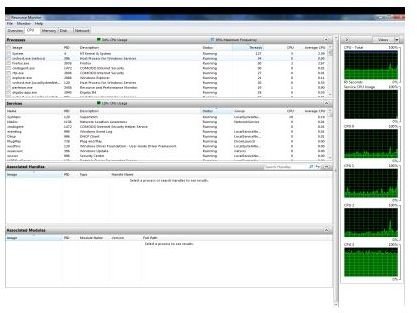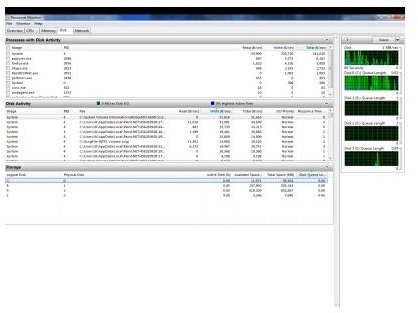Windows 7 Processor Analysis and Hard Drive Performance Monitoring
Microsoft Windows 7 contains a few more tools to monitor your system performance than previous versions. Hopefully not because there is more to go wrong!
Try right clicking the Task Bar and selecting Start Task Manager, or pressing Ctrl-Alt-Delete. This brings up the hopefully familiar Task Manager window which displays running applications, processes, services, performance, networking and users in tabs. This little application is the single most useful utility for the average user. It tells you what is running now, what percentage of your CPU and memory is being used, and other useful information.
That’s not all though. If you click onto the Performance tab you will see some nice visuals of your system.
The second image is from the CPU tab and gives an overview of what it’s doing. Again, yours may not have as many boxes on the right, as this was taken from a quad core system.
The third image is taken from the Disk tab.
The CPU tab will show you all running processes and services on your system right now. These can be sorted by any of the columns. The CPU column is perhaps the most useful as this indicates the percentage of processor time each process or service is using. If your system is running slowly, then this is a good place to come. The process or service that is taking too much CPU time might be the one that is slowing things down.
The Disk tab displays more information than you could possible need about your hard drives. The most useful thing is the Disk Activity window in the middle. This tells you exactly what is going on with your disk. If you want an overview of your disk performance, or want to know what it’s doing while its grinding away sometimes, this is the place to come. The Read and Write columns in the middle window will tell you exactly what causes the hard disk activity. Clicking on the column headers will sort the column so the process with the most activity will be at the top. This is the same for any column on any tab and is a good way to check on resource hogs.
The Resource Monitor is new for Windows 7, and there is no denying its usefulness. It can give you an excellent idea of what’s going on with your system and should be the first port of call when troubleshooting performance issues.


